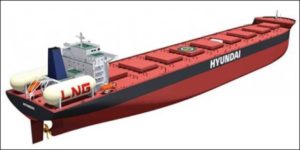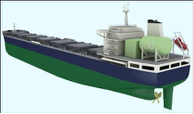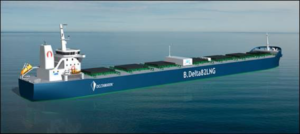LNG Fueled Bulk Carrier, Green Iris – Ship of the Week Jan 19, 2017 | West Pacific Marine
Friday December 22 was yet another milestone in the move towards use of LNG as a mainstream fuel for vessel propulsion with the naming ceremony at the Hyundai Mipo Dockyard of the LNG fueled bulk carrier Green Iris. The 50,000 MT DWT vessel, which is expected to enter service this month, has been built against a long term charter to South Korea’s major steel manufacturer POSCO for the movement of limestone. POSCO has also provided the vessel’s LNG fuel tank constructed of high manganese steel as an alternative material to more commonly used nickel alloy. The South Korean government also used the occasion to re-enforce that country’s commitment to development of an LNG bunkering infrastructure.
Built by Hyundai, Mipo Dockyard, Ulsan, South Korea
Owned and operated by Ilshin Shipping Co. Ltd.
Chartered by POSCO
DWT 50,000 MT (approx)
Main engine: MAN ME-GI

The cryogenic high manganese steel used for the LNG storage tanks on Green Iris has been some 10 years in development and successfully complies with a new standard from ASTM International which develops and publishes technical standards for many materials, including metals and non-metals. To date, more than 30,000 experts from 140 countries have established more than 12,000 technical specifications to ASTM standards for use by engineers globally. As with nickel alloy, cryogenic high manganese steel is a product that can withstand very low temperatures of -196℃ and therefore provides a new option for the LNG industry. It is also said to offer more weldability and is up to 30% cheaper than nickel alloy steel, stainless steel and aluminum alloy steel, all of which materials it seems set to eventually replace.
At a government-sponsored meeting last month to promote LNG in shipping, the South Korean Ministry of Oceans and Fisheries and the Ministry of Trade, Industry and Energy announced cooperation to examine the feasibility of building LNG fueled Capesize bulk carriers of around 180,000 tonnes DWT in the first half of 2018. Project partners will include POSCO and several shippers including Korea South East Power, Korea Gas Corp and Hanwha Chemical Co. Under the agreement, the partners will reduce or at least share the anticipated 20% premium on the cost of building such a vessel. Green Iris will be used as a prototype to “assess the direction of LNG-related shipbuilding and associated government policies”.
The development follows a pilot project launched in September investigating the shipbuilding, port and bunkering infrastructure required for such a vessel. That project involved the two ministries and another six companies: POSCO, Korea Gas Corporation, Korea Shipowners’ Association, Korea Development Bank, LNG Bunkering Industry Association and the Shipbuilding Offshore Plant Research Institute. Lloyd’s Register and Hyundai Heavy Industries (HHI) also signed a joint development project to design LNG fueled bulk carriers in June 2017 .


It doesn’t stop there however as Woodside Energy, Anangel Shipping, General Electric, Lloyds Register and HHI signed a joint industry project agreement at GASTECH 2017 to develop a 250,000dwt LNG fueled very large ore carrier (VLOC) to operate on the Australia-Asia iron ore trade. A program of work has been agreed by the parties to address design, construction and operational aspects including LNG bunkering. “The aim is to create a new generation of cost-efficient, safe, reliable and environmentally optimized design for large ore carriers”, according to Lloyd’s Register.
Lloyds Register was earlier involved in the Green Sky project to build a tri-fueled Kamsarmax sized bulk carrier with COSCO Shipyard and Golden Union Shipping (concept picture above left). Similarly, Deltamarin’s B.Delta “Project Forward” design (above right) is being pursued by Arista Shipping of Greece in partnership with ABS, Wartsila, and GTT. The concept is based on a design suitable for ships between 82,000 and 210,000 dwt and would employ GTT’s membrane-type LNG tanks for fuel containment. The Wärtsilä 31DF dual-fuel engine would form the basis of the concept’s propulsion system.

